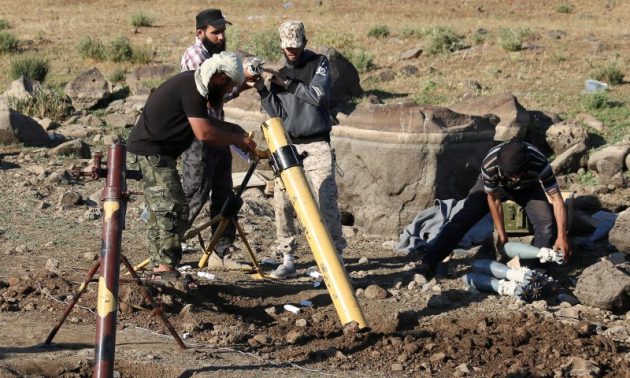Moscow plans to oversee new ‘deconfliction zone’ in country’s south, charged among other things with clearing ISIS away from Jordanian border
By Sami Moubayed
Over the past few days, the Russian army has quietly started construction of a new military base in the countryside near Damascus, from scratch, tasked with manning and administering a “deconfliction zone” in the Syrian south, similar to four others agreed upon earlier in the year by Moscow, Ankara and Tehran.The first zones applied to Homs, Idlib, and the suburbs of Damascus, while the new one will encompass territory extending from Daraa, 13 kilometers north of the Syrian-Jordanian border, to the border itself, including the strategic city of Quneitra on the Golan Heights and al-Suwayda, a mainly Druze city.
Whoever patrols it will also shoulder responsibility for purging the region of “non-Syrian” forces, in reference to al-Qaeda, Jabhat al-Nusra, ISIS and Hezbollah. The Jordanian government, a staunch and longtime ally of the United States, is keen on ridding the border region of these non-state players, asking that they are pushed back into Syrian territory by 30km to 50km.The Russians had originally wanted to restore the Syrian army to the southern front, but this was vetoed by the Americans, Jordanians and Israelis, who argued that a return of government troops would mean the return of Iranian and Hezbollah forces as well.One idea floating in thin air at present is to amend the mandate of the United Nations Disengagement Observer Force (UNDOF), whose troops have been stationed on the Syrian-Israeli border since the mid-1970s, charged with monitoring and recording ceasefire violations.
Since the outbreak of hostilities in Syria in 2011, UN troops have been frequently attacked and kid napped by warring factions, forcing them to move to the Israeli side of the border in late 2014. Only a small handful returned to Syria last December.The idea now is to equip UNDOF with firepower, giving it the right to carry arms and use them against non-state players violating the ceasefire or roaming Syrian villages and towns whether Hezbollah, al-Nusra or ISIS.
There is a high chance, however that this will never pass at the UN, because it would put the lives of foreign UN personnel at great risk, especially if they try to disarm the above-mentioned militias from both sides of the Syrian conflict. If they were to try and a war of attrition were triggered, it would be fatal for many UN troops.A more sensible idea, put forth by the Russians, is to let their troops do the dirty work, just like the 600 Russian military police who were deployed to the northern city of Aleppo earlier this year.The Russians have already agreed to restore a “Syrian civil authority” to administer the new deconfliction zone, meaning government schools and police stations in the city of Daraa but no soldiers, tanks, or warplanes.The Russians insist that Damascus raise the Syrian flag in Daraa and reopen the Nasib border crossing between Syria and Jordan, which is vital for the two countries’ bilateral trade, while assuring stakeholders it will no longer bomb these territories nor arrest armed opposition groups who agreed to join forces in the war on terror.Details on who will patrol the entire zone, however, and what its parameters will be are up for discussion at the next round of talks in Astana on July 4-5, co-chaired by Moscow, Tehran and Ankara.
The new Russian base, earmarked to supervise the new deconfliction zone, will be in the town of Khirbet Raes al-Waer, around 50km from the Syrian capital and 96km from the Syrian-Jordanian border. A stone’s throw from Damascus, it is strategically located 110km south of the Syrian Golan.The new base will be Moscow’s third in Syria after Khmeimim, southeast of Latakia, and another in the port city of Tartus. Both were set up and expanded to support the Russians’ military operations against ISIS, shortly after they officially entered the Syrian battlefield in September 2015. All three bases are only accessible to Russian military personnel, and their territory has been leased to the Russian government for a period of 49 years, renewable for an additional 25 years by “mutual consent” between Damascus and Moscow.The sophisticated military infrastructure found in the first two bases will likely be copied in Khirbet Raes al-Waer; they include air-defense systems, radars, runways, missile launchers, bunkers, control towers, refueling stations, and housing units for 1,000 Russian soldiers each.The role of the new base will be to implement an eight-point program agreed upon this month by Russia, the US and Jordan, which includes preventing troops from both sides of the Syrian conflict from exchanging fire across the Damascus-Daraa Highway, creating pockets for the opposition, and supervising the evacuation of “non-Syrian troops” into the agreed buffer 30-50km from the border.They will also be tasked with making sure that humanitarian aid reaches besieged villages and towns, and that both sides of the conflict respect the ceasefire and unite their efforts to eradicate al-Nusra and ISIS from the Syrian south.
‘Courtesy Asia Times Online’.


